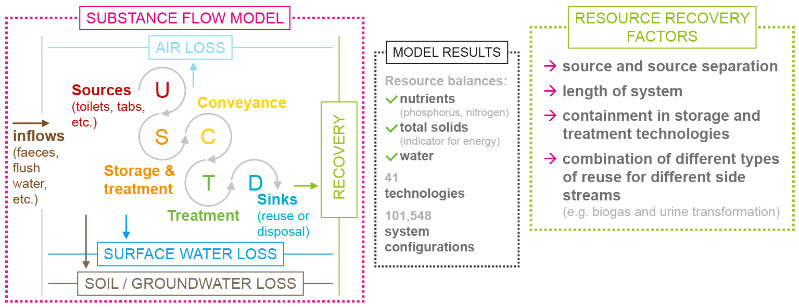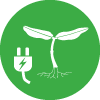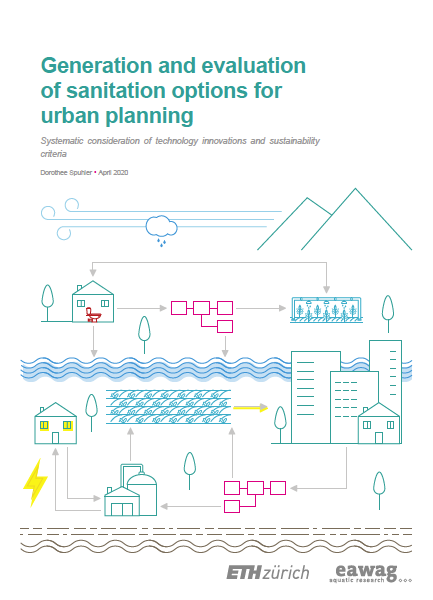- Forum
- categories
- Markets, finance and governance
- Cities (planning, implementation, and management processes)
- Cities sanitation planning toolkits and guidance publications
- Tools for the generation of sanitation systems considering novel technology options and for the quantification of nutrient, water, and total solid balances at the scale of an urban setting
Tools for the generation of sanitation systems considering novel technology options and for the quantification of nutrient, water, and total solid balances at the scale of an urban setting
34.2k views
- HarryTams
-
Less
- Posts: 31
- Likes received: 14
Re: Tools for the generation of sanitation systems considering novel technology options and for the quantification of nutrient, water, and total solid balances at the scale of an urban setting
Please Log in to join the conversation.
You need to login to reply- Heiner
-

- I am a retired organic farmer and interested in nutrient cycles. As an volunteer I now travel mainly to poor countries and together with locals I would like to find new ways of sustainable agriculture. This is beyond the regulations of IFOAM.
Less- Posts: 79
- Karma: 1
- Likes received: 67
Re: Tools for the generation of sanitation systems considering novel technology options and for the quantification of nutrient, water, and total solid balances at the scale of an urban setting
thanks very much for sharing your work and information!! To me (not a real expert, I must admit..) it sounds like a very helpful tool for our efforts to improve things on the way to close the loop. More and more people at least understand the importance of CE and your work hopefully contributes to it.
I startet to read your thesis and if lucky will finish it in 2021.... If questions come up I let you know
I am very happy you have a focus on nitrogen, the most important nutrient we have to look after. And if we do not look after the biggest polluter for environmental damage. Relating to the question of Elisabeth and you answer I very much agree this is very difficult to monetarise but there is no time left to ignore.
I would have asked too...what about vermitechnology as is practised in lots of places and obviously a rising thing in in India. But you gave your answer.
Working for ETH you are not far away from FiBL. Do you have any contact to them? And are they in a way interested in your work? I would appreciate very much cause their is a sort of arrogance in the organic scenery not to close the loop. And I think we have to push from all sides.....
Last first question: what losses do you expect if the material of this dry toilet (faeces an sawdust or fine wood chips) is heated up to 70 degrees Celsius for one week?
finizio.de/pilotanlage/
Much success or you,
Heiner
Please Log in to join the conversation.
You need to login to replyRe: Tools for the generation of sanitation systems considering novel technology options and for the quantification of nutrient, water, and total solid balances at the scale of an urban setting
Thank you for your questions.
Let me take it bottom-up
3) Financial values: Without looking in detail into the named publication and discussion, which is certainly interesting and valuable, my first quick answer would be:
I strongly believe in the multi-dimensionality of sustainable development as well as in value-based society rather than a money-based economy. Therefore, I have my doubts regarding conclusions that are drawn from solely financial assessment. However, I provide the amounts (volumes or masses) of phosphorus, nitrogen, total solids, and water that can be recovered at a city level. Taking some estimates of local market prices, these amounts can quite easy be translated to financial value…
2) Inclusion/exclusion of technologies: The set of technologies which were considered are NOT meant to be comprehensive nor to provide some sort of expert selection of “good options”. The set of technologies was chosen regarding the two main criteria: do they help to illustrate the diversity of the option space (from a technology and system design point of view) and is data available. The first criteria was based on the fact, that we wanted to illustrate the method and what it can do. I would have loved to include more technologies but in the time I had, this was not possible. HOWEVER the model which I used is flexible to consider and technology and I am currently preparing an open source version of the algorithm as well as a editable technology library to adapt for one’s own purposes. It is still under development and the purpose of this raw models is really to be used by experts (a simplified web-application for capacity development is also under development) but you can always access it here:
github.com/santiago-sanitation-systems/Santiago.jl
github.com/santiago-sanitation-systems/S...n-technology-library
1) Wikipedia: This one could go into either one or the other Wikipedia article. I have a slight preference for the one on “sustainable sanitation” but this is probably already quite packed…. “reuse of excreta” for me is to narrow, I do look also on wet and centralized systems :
“Based on our analysis, we developed five recommendations for the optimization of resource recovery: (i) prioritize short systems that close the loop at the lowest possible level; (ii) separate waste streams as much as possible, because this allows for higher recovery potentials; (iii) use storage and treatment technologies that contain the products as much as possible, avoid leaching technologies (e.g. single pits) and technologies with high risk of volatilization (e.g. drying beds); (iv) design sinks to optimise recovery and avoid disposal sinks; and (v) combine various reuse options for different side streams (e.g. urine diversion systems that combine reuse of urine and production of biofuel from faeces).” Spuhler et al. 2020, doi.org/10.1016/j.watres.2020.116281
By the way, my thesis is now also online (and open source):
Generation and evaluation of sanitation options for urban planning: systematic consideration of
technology innovations and sustainability criteria, Dorothee Spuhler, 2020
doi.org/10.3929/ethz-b-000444234
To make urban water management more sustainable, many novel sanitation technologies and system configurations have been developed recently. Many of these innovations allow for resource recovery and reuse and are independent from energy, water, and sewer networks. This makes them more resilient to changing environmental and socio-demographic conditions and thus more appropriate for developing urban areas. But while novel technologies and systems potentially enhance sustainability, they also increase planning complexity: how can the different technologies be assembled into entire systems? How appropriate are the resulting systems for a given application case? And how can relevant sustainability indicators such as resource recovery and losses be quantified?
This thesis contributes with a theoretical description, implementation, and practical applications of methods for: (1) the generation of all valid system configurations from a set of potential technologies considering innovations; (2) the identification of a set of locally appropriate systems as an input into strategic planning using a structured decision-making approach; and (3) the ex-ante quantification of resource recovery potentials of entire systems consider.
The methods are generic to be applied to any case or (future) technology, flexible to fit into any international established planning procedures; automated to consider a diverse and large set of potential options; systematic to enhance transparency; and explicitly consider uncertainty related to technology implementation or the local context. Because one of the main challenges in practice is the lack of knowledge and data, especially for novel technologies, the methods are complemented with a technology library providing international data and expert knowledge to be matched to the local conditions. The practical experiences from six case studies showed that the approach allows the prioritisation of more appropriate and more resource efficient systems when strategically planning for sanitation improvements. As more technology and sanitation system options are
added to the already large portfolio, the methods presented in this thesis may become an essential tool for the putting SDG 6.2, 6.3 and SDG 11 into practice.
Thank you for your interest!
Dorothee
Developing methods and tools to support strategic planning for sustainable sanitation. Particular interested in novel technologies contributing to more inclusive and circular sanitation. This email address is being protected from spambots. You need JavaScript enabled to view it.
Attachments:
Please Log in to join the conversation.
You need to login to reply- Elisabeth
-
- Moderator
- Freelance consultant since 2012 (former roles: program manager at GIZ and SuSanA secretariat, lecturer, process engineer for wastewater treatment plants)
Less- Posts: 3372
- Karma: 54
- Likes received: 931
Re: Tools for the generation of sanitation systems considering novel technology options and for the quantification of nutrient, water, and total solid balances at the scale of an urban setting
Some thoughts:
1) Is there anything in there that could be inserted into relevant Wikipedia articles? Which Wikipedia articles would be the most relevant? Maybe the ones on sustainable sanitation or reuse of excreta ?
2) I still find it a pity that vermifiltration is not included as one of the technologies (but vermicomposting is) - we talked about that earlier in this thread (see above). Was vermifiltration a technology that "almost" made it in or not by a long shot? Which are the "novel technologies" that you think are closest to being included in a future version (or by future users themselves)? See also here on the forum.
3) Hajo and Heiner have recently been discussing with Alison and Adrian their perhaps pessimistic conclusion of their paper "A Review of the Financial Value of Faecal Sludge Reuse in Low-Income Countries". See here . Can your work shed any light on that issue? Or can your tool be used to investigate the financial value of faecal sludge reuse?
Regards,
Elisabeth
Freelance consultant on environmental and climate projects
Please Log in to join the conversation.
You need to login to replyRe: Tools for the generation of sanitation systems considering novel technology options and for the quantification of nutrient, water, and total solid balances at the scale of an urban setting
For some reasons, the article was behind a paywall. The problem has now been resolved and you can access the article directly here:
doi.org/10.1016/j.watres.2020.116281
I would be more than happy if you have questions or feedback
Dorothee
Developing methods and tools to support strategic planning for sustainable sanitation. Particular interested in novel technologies contributing to more inclusive and circular sanitation. This email address is being protected from spambots. You need JavaScript enabled to view it.
Please Log in to join the conversation.
You need to login to replyRe: Tools for the generation of sanitation systems considering novel technology options and for the quantification of nutrient, water, and total solid balances at the scale of an urban setting
A new open source paper from my PhD is out:
Comparative analysis of sanitation systems for resource recovery: Influence of configurations and single technology components
doi.org/10.1016/j.watres.2020.116281
The paper comes with a data package compiling international literature and expert information on 41 technologies, their appropriateness profiles for different context, and transfer coefficients for phosphorus, nitrogen, total solids, and water. This package can be directly accessed here: opendata.eawag.ch/dataset/sanitation-technology-library
Please come back to me with your feedback and questions!
Abstract
Resource recovery and emissions from sanitation systems are critical sustainability indicators for strategic urban sanitation planning. In this context, sanitation systems are the most often structured using technology-driven templates rather than performance-based sustainability indicators. In this work, we answer two questions: Firstly, can we estimate generic resource recovery and loss potentials and their uncertainties for a diverse and large set of sanitation systems? And secondly, can we identify technological aspects of sanitation systems that indicate a better overall resource recovery performance? The aim is to obtain information that can be used as an input into any strategic planning process and to help shape technology development and system design for resource recovery in the future. Starting from 41 technologies, which include novel and conventional options, we build 101,548 valid sanitation system configurations. For each system configuration we quantify phosphorus, nitrogen, total solids, and water flows and use that to calculate recovery potentials and losses to the environment, i.e. the soil, air, or surface water. The four substances cover different properties and serve as a proxy for nutrient, organics, energy, and water resources. For modelling the flows ex-ante, we use a novel approach to consider a large range of international literature and expert data considering uncertainties. Thus all results are generic and can therefore be used as input into any strategic planning process or to help guide future technology development. A detailed analysis of the results allows us to identify factors that influence recovery and losses. These factors include the type of source, the length of systems, and the level of containment in storage and treatment. The factors influencing recovery are related to interactions of different technologies in a system which shows the relevance of a modelling approach that allows to look at all possible system configurations systematically. Based on our analysis, we developed five recommendations for the optimization of resource recovery: (i) prioritize short systems that close the loop at the lowest possible level; (ii) separate waste streams as much as possible, because this allows for higher recovery potentials; (iii) use storage and treatment technologies that contain the products as much as possible, avoid leaching technologies (e.g. single pits) and technologies with high risk of volatilization (e.g. drying beds); (iv) design sinks to optimise recovery and avoid disposal sinks; and (v) combine various reuse options for different side streams (e.g. urine diversion systems that combine reuse of urine and production of biofuel from faeces).
Developing methods and tools to support strategic planning for sustainable sanitation. Particular interested in novel technologies contributing to more inclusive and circular sanitation. This email address is being protected from spambots. You need JavaScript enabled to view it.
Attachments:
-
 Graphical_...lice.jpg
(Filesize: 130KB)
Graphical_...lice.jpg
(Filesize: 130KB)
Please Log in to join the conversation.
You need to login to replyRe: Tools for the generation of sanitation systems considering novel technology options and for the quantification of nutrient, water, and total solid balances at the scale of an urban setting
We (me, my colleagues from 500B Nepal, Arba Minch Ethiopia, and Eawag Switzerland) finally managed to get out the results of the method we developped during my PhD, it is available here :
Developing sanitation planning options: A tool for systematic consideration of novel technologies and systems
Dorothee Spuhler, Verena Germann, Kinfe Kassa, Atekelt Abebe Ketema, Anjali Manandhar Sherpa, Mingma Gyalzen Scherpa, Max Maurer, Christoph Lüthi, Günter Langergraber
The approach enables the prioritisation of appropriate and resource efficient sanitation technologies and systems in strategic planning . It contributes to a more citywide inclusive approach by bridging strategic citywide objectives with an area-based appropriateness assessment.
Abstract
To provide access to sustainable sanitation for the entire world population, novel technologies and systems have been developed. These options are often independent of sewers, water, and energy and therefore promise to be more appropriate for fast-growing urban areas. They also allow for resource recovery and and are adaptable to changing environmental and demographic conditions what makes them more sustainable.
More options, however, also enhance planning complexity. Structured decision making (SDM) can help balance opposing interests. Yet, most of the current research focuses on the selection of a preferred option, assuming that a set of appropriate options is available. There is a lack of reproducible methods for the identification of sanitation system planning options that can consider the growing number of available technology and the many possible system configurations. Additionally, there is a lack of data, particularly for novel options, to evaluate the various sustainability criteria for sanitation.To overcome this limitation, we present a novel software supported approach: the SANitation sysTem Alternative GeneratOr (Santiago).
To be optimally effective, Santiago is required to be integrated into an SDM approach. In this paper, we present all the elements that such anintegration requires and illustrate these methods at the case of Arba Minch, a fast growing town in Ethiopia. Based on this example and experiences from other cases, we discuss the lessons learnt and present the advantages potentially brought by Santiago for sanitation planning The integration requires four elements: a set of technologies to be looked at, decision objectives for sustainable sanitation, screening criteria to evalute technology appropriateness, and about the technologies and the casea. The main output is a set of sanitation system options that is locally appropriate, diverse in order to reveal trade-offs, and of a manageable size. To support the definition of decision objectives, we developed a generic objective hierarchy for sustainable sanitation. Because one of the main challenges lies in the quantification of screening criteria, we established the data for 27 criteria and 41 technologies in a library.The case studies showed, that if the integration is successful, then Santiago can provide substantial benefits: (i) it is systematic and reproducible; (ii) it opens up the decision space with novel and potentially more appropriate solutions; (iii) it makes international data accessible for more empirical decision making; (iv) it enables decisions based on strategic objectives in line with the sustainable development goals; (v) it allows to prioritise appropriate and resource efficient systems right from the beginning (vi) and it contributes to a more citywide inclusive approach by bridging strategic objectives with an area-based appropriateness assessment.
The here presented approach enables the prioritisation of appropriate and resource efficient sanitation technologies and systems in strategic planning. Thereby this approach contributes to SDG 6.2, 6.3, and 11, sustainable sanitation for all.
Please log in or register to see it.
Developing methods and tools to support strategic planning for sustainable sanitation. Particular interested in novel technologies contributing to more inclusive and circular sanitation. This email address is being protected from spambots. You need JavaScript enabled to view it.
This message has an attachment file.
Please log in or register to see it.
Please Log in to join the conversation.
You need to login to replyRe: Factsheet on new tool to identify locally appropriate sanitation system options for planning
Thanks for the further questions!
I do not have a link where all the novel technologies are listed as I am yet in the progress of preparing a easily accessible user interface for the tool. I could share the link to a few publications where one or the other technology was included in the case study. But I hope soon the publication process on my current technology database will be done and then I will definitively share the link.
However, important is not the list of the technologies that are included, but that I am to produce a online version of the Compendium where novel options can be more easily added. From a methodological point of view, this means that the generic definitions and attributes used by the new Compendium are flexible and can be defined by the user. AND, that is what I mentioned in my previous thread: the uncertainty regarding those data especially for novel technologies can be considered. From a practical point of view, I still need to sort out how exactely to tag novel technologies to distinguish them from the others from the Compendium (you may remember that the Compendium facthsheets went through a very long and intensive reviewing process with a broad sounding board… not sure if this will be possible for each new technology added).
To be more specific:
- For the technology appropriateness assessment I consider the uncertainty of the the different attributes (e.g. water requirements) using probability functions. However, the overall technology score is a number between 0 and 100% (without standard deviation) expressing the confidence we have in the technology to be appropriate.
- For the mass flow quantification I consider the uncertainties related to the transfer coefficients resulting in a standard deviation for the quantified resource recovery and losses potentials (phosphorus, nitrogen, total solids, water). This is particularly important for novel technologies, but also for conventional technologies, transfer coefficients ARE uncertain (imagine the variability you have of the fraction of phosphorus entering the sludge and the effluent in a septic tank….). To quantify the uncertainty, I used the variability of data from different literature resources, the technology readiness level (TRL), and the confidence in the substance (e.g. phosphorus being conservative and nitrogen not).
- My cost module is really only a prototype and I paused working on it as I want to see what comes out of the World Bank costing tool and other initiatives e.g. lead by Leeds. I used cost functions of the CLARA tool and previous Eawag work and only considered uncertainty (better said “variability” ) regarding the number of users per unit (e.g. do you have one, two, or three, FSM treatment plants within a settlement).
- Aurin production: this is the process currently implemented by VUNA mainly here in Switzerland and surroundings – check it out (it is now also allowed for edible crops !!!): www.vuna.ch/aurin/index_en.html.
You already state one answer to the problem, often provided by decision analysis theory: by quantifying the risk associated to different performance indicators used to compare options, we can consider this risk and thus also compare options with very different risks in the decision-making process! It is then to the decision-makers providing a value function describing how risk adverse he is…“I think it's been a shortcoming for a long time that novel options are not included in many decision-making processes. On the other hand, I can also understand why that might be so. It's about risk of failure and who would be willing to shoulder the risks of implementing a little-known technology on a larger scale...”
Considering various uncertainties is one attempt to do this and the models I developed are the first step to consider novel options alongside with conventional ones. It provides however not the final solutions, but a set of options to be further evaluated regarding different criteria, maybe weighted differently by different stakeholders. One or several risk proxies as part of the criteria would allow to consider the fear of decision-makers of failure of novel technologies (and quantifying those systematically may reveals that given the local environmental factors, the actual risk of novel options are not higher than for conventional ones: e.g. imagine a very robust but strongly water dependent technology compared to a highly novel waterless option in a water scarce area…).
I am extremely happy that we have this discussion, Elisabeth! I think these aspects have not been enough discussed on the forum although they are so crucial to bring the many innovations into practice!
Kind regards,
Dorothee
Developing methods and tools to support strategic planning for sustainable sanitation. Particular interested in novel technologies contributing to more inclusive and circular sanitation. This email address is being protected from spambots. You need JavaScript enabled to view it.
Please Log in to join the conversation.
You need to login to reply- Elisabeth
-
- Moderator
- Freelance consultant since 2012 (former roles: program manager at GIZ and SuSanA secretariat, lecturer, process engineer for wastewater treatment plants)
Less- Posts: 3372
- Karma: 54
- Likes received: 931
Re: Factsheet on new tool to identify locally appropriate sanitation system options for planning
Could you please expand a bit more on this:
?The novel technologies include vermi-composting, aurin production, biochar production, etc. Different technologies have different uncertainties either because of lack of experiences or the huge diversity in design specifications. I offer a way of comparing technology appropriateness and quantifying mass flows which can take this into account.
Could you provide a link to the page where ALL the "novel" technologies are listed (i.e. all those that were not in the EAWAG eCompendium). I don't know aurin production or was that a typo? And could you explain how you factor in those uncertainties, also for your cost equations.
I think it's been a shortcoming for a long time that novel options are not included in many decision making processes. On the other hand, I can also understand why that might be so. It's about risk of failure and who would be willing to shoulder the risks of implementing a little known technology on a larger scale...
Regards,
Elisabeth
Freelance consultant on environmental and climate projects
Please Log in to join the conversation.
You need to login to replyRe: Factsheet on new tool to identify locally appropriate sanitation system options for planning
Thank you, Elisabeth, for your post
Yes, it is the continuation of my PhD work and aims to put it into practice.
Yes, I also sometimes think the same thing: not yet another tool… but this is really not the intention!
The aim is to bring the Compendium to a next level and equip it with additional functions:
- Systematic assessment of the technology APPROPRIATENESS IN A GIVEN CASE considering novel technologies and thus the uncertainties related to those and the local conditions
- Generate possible and VALID SYSTEM CONFIGURATION from a set of appropriate technologies.
- Identify SYSTEMATICALLY a set of system option as INPUT INTO STRATEGIC PLANNING (e.g. CLUES, Sanitation21, CWIS, etc.)
- And optionally quantify resource recovery potentials and losses to soil, water, air (phosphorus, nitrogen, total solids, water)
My current project aims at bringing the elements from SANTIAGO online in a new eCompendium integrating the features mentioned above. This eCompendium can then be used as a decision-making support tool, as a training and capacity development tool, but also to test out the scope of new technology innovation (e.g. technology innovation XY would lead to what kind of possible system configurations… OR to make technology ZW appropriate for developing urban areas, what features need to be improved…, etc..). It should be targeted to consultants (e.g. for ADB or the World Bank), planners, policy makers, development agencies, academia, and training institutions.
Yes, it can also be a sort of a meta tool (as the compendium) bringing in the system approach into other tools such as the FSM toolbox, the World Bank Costing tool, the online version of the Compendium for Emergencies, Sampson, etc. For instance, all these tools require that technologies are assembled into entire and valid system chains. So far, this needs to be done manually depending on the knowledge and expertise of the expert, limiting the diversity of the system options to a few well known only. This could be systematized which would also allow to deal with very large numbers also and opening up the option space for novel options, which are potentially more appropriate and sustainable.
I am currently applying for different funding sources and in contact with different related tool to sketch out the integration (e.g. FSM toolbox, SSWM toolbox, CSTEP planning tool, Compendium for Emergencies, etc.). I also aim to have an eCompendium version that could be co-hosted by several relevant websites, including the SuSanA website, Eawag website, and the SSWM toolbox website.
In summary:
- SANTIAGO is a meta tool providing advanced functionalities as a complement to the Compendium
- The aim is a eCompendium3.0: an online open source user interface for capacity development and training, planning/decision-making support, and scoping of new technologies.
- The functionalities could also be integrated in other tools (e.g. generating system configurations in the FSM toolbox.
- It is by no means intended to replace the technical know-how required for detailed planning and implementation but serves to help integrate the growing number of decision criteria and technological options into the decision-making process.
Did I answer all your question?
By the way, I also presented some more practical conclusions from the case study from Nepal at WEDC last year and I am also working of extending SANTIAGO for cost estimations – two short papers attached.
Cheers, Dorothee
Developing methods and tools to support strategic planning for sustainable sanitation. Particular interested in novel technologies contributing to more inclusive and circular sanitation. This email address is being protected from spambots. You need JavaScript enabled to view it.
This message has attachments files.
Please log in or register to see it.
Please Log in to join the conversation.
You need to login to reply- Elisabeth
-
- Moderator
- Freelance consultant since 2012 (former roles: program manager at GIZ and SuSanA secretariat, lecturer, process engineer for wastewater treatment plants)
Less- Posts: 3372
- Karma: 54
- Likes received: 931
Re: Factsheet on new tool to identify locally appropriate sanitation system options for planning
I want to give your post a boost by putting it back on top as it looks really interesting! Is this a continuation of your PhD work? Putting your PhD work into practice? (you had earlier written about it here, should we perhaps combine the threads?: forum.susana.org/wastewater-characterisa...-of-an-urban-setting) (edit on 24 Sept: merger now done)
When I first looked at it I thought, "not another tool..." But maybe this will be the tool of all tools?
I think one difficult area will always be how do you compare the better known technologies with the lesser known technologies side by side? I think in practice many decision makers will naturally gravitate towards technologies that have been around for longer and shy away from those that are less well established.
For example think of vermifiltration for wastewater treatment which Hajo and Dean (and a few others) have been discussing here: forum.susana.org/205-vermifilters-or-ver...-produce-clean-water
It might have merit and potential (I can't judge it myself) but it will be hard for it to be taken seriously because of the small number of well documented implementations at a larger scale so far. How will it therefore be included (or not) in your SANTIAGO tool?
Other lesser known technologies where the same question applies could be container-based sanitation, vermifilters for blackwater treatment (worm toilets), some of those new technologies coming out the BMGF toilet grants (although they are presumably all still at an early stage and therefore NOT included in your tool (?))
Also you wrote here :
Is that progressing?I am also in discussion with Manfred ( forum.susana.org/wastewater-characterisa...lable-sampsons#27548 ) to integrate some of these models in their new software.
And I am a little bit confused: is SANTIAGO more of a mathematical modelling thing (which is the sub-category where you had posted about your PhD thesis) or more of a planning toolkit thing (which is where this thread is now)?
Regards,
Elisabeth
Freelance consultant on environmental and climate projects
Please Log in to join the conversation.
You need to login to replyRe: Factsheet on new tool to identify locally appropriate sanitation system options for planning
As the number of potential sanitation technologies grows, it becomes increasingly complex to combine those into appropriate and sustainable systems. How compatible are different technologies? How to ensure that all waste streams are treated? How to systematically evaluate the appropriateness of a system for a given urban setting? Such questions become more relevant than ever.
We are currently in the process of developing a new open-source online tool that enables engineers in considering systematically the growing number of new sanitation technologies and systems when choosing among options. The tool is designed to integrate in a facilitated participatory strategic planning process (following a structured decision-making approach such as CLUES) and provides a diverse set of sanitation system options, all appropriate for the case at hand. A library of over 50 technologies makes data from international literature and expert knowledge (e.g. energy requirements, access requirements) available to the local actors. The library can easily be extended in order to capture future innovations.
Please find enclosed a short factsheet about it. So far, we have tested the tool in two cases in Nepal, two studies in Ethiopia, and one in Peru.
As we are now preparing to make this tool available online, we are looking for your feedback and future testers (you can find my email address in the orange box at the end of the factsheet.
We also would like to have the feedback on two questions from the SuSanA crowd:
- Do we need such a tool?
- And where should it be hosted, respectively, how should it be accessed (e.g. FSM toolbox, SuSanA homepage, SSWM Toolbox, etc.)?
THANK YOUR FOR YOUR SUPPORT!
Dorothee
Please log in or register to see it.
Please log in or register to see it.
Please log in or register to see it.
Developing methods and tools to support strategic planning for sustainable sanitation. Particular interested in novel technologies contributing to more inclusive and circular sanitation. This email address is being protected from spambots. You need JavaScript enabled to view it.
This message has attachments files.
Please log in or register to see it.
Please Log in to join the conversation.
You need to login to reply- Forum
- categories
- Markets, finance and governance
- Cities (planning, implementation, and management processes)
- Cities sanitation planning toolkits and guidance publications
- Tools for the generation of sanitation systems considering novel technology options and for the quantification of nutrient, water, and total solid balances at the scale of an urban setting








